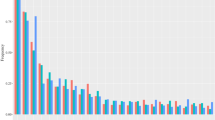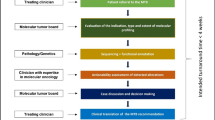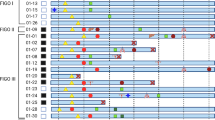Abstract
Ovarian cancer is the second most frequently diagnosed gynecologic malignancy, and causes higher mortality than any other cancer in the reproductive system. Recognizing predictive markers of development and progression of this cancer would facilitate to individualize therapy and improve survival of ovarian cancer patients. Detection of genetic aberrations using array based comparative genomic hybridization (array CGH) has been implicated as one of important tools for identifying diagnostic and prognostic markers in various cancers, leading to the interesting study that exploration of copy number alterations in serous ovarian cancer at IIIc stage with the ultimate goal to discover potential predictive markers. To gain the best opportunities for exploring genomic imbalance involved in modulation of cancer development and progression, homogenous samples were selected as concerning with histology and stage in which we applied the array CGH with high resolution of one million formats. Here, the array CGH analysis obviously revealed significant DNA copy number changes (gain and loss) in Korean ovarian cancer patients at serous histological IIIc stage. We discovered DNA copy number gain in chromosome 6p22.3 whereas DNA copy number loss in chromosome 8p21.1-p12 and chromosome 11p15.4, with relatively high frequency of genomic alteration (83.3%). Upon these chromosomal regions, we eventually identified 32 genes including DUSP4, ID4, NRG1, and RRM1. We also classified their functions by gene ontology (GO) analysis using DAVID program and consequently demonstrated various interesting GO terms including biological regulation and positive regulation of cell growth. Taken together, these identified genes might be considered as potential predictive markers for further target-based strategies for diagnosis in Korean ovarian cancer patients at serous histological IIIc stage. These studies might also help understanding of tumorigenesis and the progression of ovarian carcinomas, in the aspect of genetic variations.
Similar content being viewed by others
References
McGuire, W. P. 3rd & Markman, M. Primary ovarian cancer chemotherapy: current standards of care. Br J Cancer 3:3S–8S (2003).
Heintz, A. P. et al. Carcinoma of the ovary. Int J Gynaecol Obstet 1:135–166 (2003).
Piccart, M. et al. Randomized intergroup trial of cisplatin-paclitaxel versus cisplatin-cyclophosphamide in women with advanced epithelial ovarian cancer: three-year results. J Natl Cancer Inst 92:699–708 (2000).
Kim, G. J. et al. Detection of genetic alterations in Korean ovarian carcinomas by degenerate oligonucleotide primed polymerase chain reaction-comparative genomic hybridization. Cancer Genet Cytogenet 147: 23–27 (2003).
Kim, H. S. et al. Genetic polymorphisms affecting clinical outcomes in epithelial ovarian cancer patients treated with taxanes and platinum compounds: A Korean population-based study. Gynecologic Oncology 113:264–269 (2009).
Hiorns, L. R. et al. Variation in RNA expression and genomic DNA content acquired during cell culture. Br J Cancer 90:476–482 (2004).
Telenius, H. et al. Degenerate oligonucleotide-primed PCR: general amplification of target DNA by a single degenerate primer. Genomics 13:718–725 (1992).
Mantripragada, K. K., Buckley, P. G., de Stahl, T. D. & Dumanski, J. P. Genomic microarrays in the spotlight. Trends Genet 20:87–94 (2004).
Squire, J. A. et al. Molecular cytogenetic analysis of head and neck squamous cell carcinoma: by comparative genomic hybridization, spectral karyotyping, and expression array analysis. Head Neck 24:874–887 (2002).
Heiskanen, M. et al. CGH, cDNA and tissue microarray analyses implicate FGFR2 amplification in a small subset of breast tumors. Anal Cell Pathol 22:229–234 (2001).
Prasad, M. et al. High definition cytogenetics and oligonucleotide aCGH analyses of cisplatin-resistant ovarian cancer cells. Genes Chromosomes Cancer 47:427–436 (2008).
Staebler, A. et al. Chromosomal losses of regions on 5q and lack of high-level amplifications at 8q24 are associated with favorable prognosis for ovarian serous carcinoma. Genes Chromosomes Cancer 45:905–917 (2006).
Kim, S. W. et al. Analysis of chromosomal changes in serous ovarian carcinoma using high-resolution array comparative genomic hybridization: Potential predictive markers of chemoresistant disease. Genes Chromosomes Cancer 46:1–9 (2007).
Bernardini, M. et al. High-resolution mapping of genomic imbalance and identification of gene expression profiles associated with differential chemotherapy response in serous epithelial ovarian cancer. Neoplasia 7:603–613 (2005).
Osterberg, L., Levan, K., Partheen, K., Helou, K. & Horvath, G. Cytogenetic analysis of carboplatin resistancein early-stage epithelial ovarian carcinoma. Cancer Genet Cytogenet 163:144–150 (2005).
Suzuki, S. et al. An approach to analysis of large-scale correlations between genome changes and clinical endpoints in ovarian cancer. Cancer Res 60:5382–5385 (2000).
Birrer, M. J. et al. Whole genome oligonucleotide-based array comparative genomic hybridization analysis identified fibroblast growth factor 1 as a prognostic marker for advanced-stage serous ovarian adenocarcinomas. J Clin Oncol 25:2281–2287 (2007).
Nanjundan, M. et al. Amplification of MDS1/EVI1 and EVI1, located in the 3q26.2 amplicon, is associated with favorable patient prognosis in ovarian cancer. Cancer Res 67:3074–3084 (2007).
Mayr, D. et al. Analysis of gene amplification and prognostic markers in ovarian cancer using comparative genomic hybridization for microarrays and immunohistochemical analysis for tissue microarrays. Am J Clin Pathol 126:101–109 (2006).
Farley, J. et al. Cyclin E expression is a significant predictor of survival in advanced, sub optimally debulked ovarian epithelial cancers: a Gynecologic Oncology Group study. Cancer Res 63:1235–1241 (2003).
Nakao, K. et al. High-resolution analysis of DNA copy number alterations in colorectal cancer by array-based comparative genomic hybridization. Carcinogenesis 25:1345–1357 (2004).
Tabarés-Seisdedos, R. & Rubenstein, J. L. Chromosome 8p as a potential hub for developmental neuropsychiatric disorders: implications for schizophrenia, autism and cancer. Mol Psychiatry 14:563–589 (2009).
Turner, N. et al. Intergrative molecular profiling of triple negative breast cancers identifies amplicon drivers and potential therapeutic targets. Oncogene 29:2013–2023 (2010).
Desprez, P. Y., Sumida, T. & Coppe, J. P. Helix-loophelix proteins in mammary gland development and breast cancer. J Mammary Gland Biol Neoplasia 8:225–239 (2003).
Norton, J. D. ID helix-loop-helix proteins in cell growth, differentiation and tumorigenesis. J Cell Sci 113:3897–3902 (2000).
Noetzel, E. et al. Promoter methylation-associated loss of ID4 expression is a marker of tumour recurrence in human breast cancer. BMC Cancer 8:154 (2008).
Beger, C. et al. Identification of Id4 as a regulator of BRCA1 expression by using a ribozyme-library-based inverse genomics approach. PNAS 98:130–135 (2001).
Douglas, L. F. Neuregulins: functions, forms, and signaling strategies. Exp Cell Res 284: 14–30 (2003).
Chua, Y. L. et al. The NRG1 gene is frequently silenced by methylation in breast cancers and is a strong candidate for the 8p tumour suppressor gene. Oncogene 28:4041–4052 (2009).
Pole, J. C. et al. High-resolution analysis of chromosome rearrangements on 8p in breast, colon and pancreatic cancer reveals a complex pattern of loss, gain and translocation. Oncogene 25:5693–5706 (2006).
Prentice, L. M. et al. NRG1 gene rearrangements in clinical breast cancer: identification of an adjacent novel amplicon associated with poor prognosis. Oncogene 24:7281–7289 (2005).
Owens, D. M. & Keyse, S. M. Differential regulation of MAP kinase signalling by dual-specificity protein-phosphatases. Oncogene 26:3203–3213 (2007).
Yip-Schneider, M. T. et al. Pancreatic tumor cells with mutant K-ras suppress ERK activity by MEK-dependent induction of MAP kinase phosphatase-2. Biochem Biophys Res Commun 280:992–997 (2001).
Sieben, N. L. et al. Differential gene expression in ovarian tumors reveals Dusp 4 and Serpina 5 as key regulators for benign behavior of serous borderline tumors. J Clin Oncol 23:7257–7264 (2005).
Venter, D. J. et al. Complex CGH alterations on chromosome arm 8p at candidate tumor suppressor gene loci in breast cancer cell lines. Cancer Genet Gytogenet 160:134–140 (2005).
Wang, Y. et al. Gene-expression profiles to predict distant metastasis of lymph node negative primary breast cancer. Lancet 365:671–678 (2005).
Rosell, R., Taron, M., Camps, C. & López-Vivanco, G. Influence of genetic markers on survival in non-small cell lung cancer. Drugs Today (Barc) 39:775–786 (2003).
Ferrandina, G. et al. Expression of nucleoside transporters, deoxycitidine kinase, ribonucleotide reductase regulatory subunits, and gemcitabine catabolic enzymes in primary ovarian cancer. Cancer Chemother Pharmacol 65:679–686 (2010).
Author information
Authors and Affiliations
Corresponding authors
Rights and permissions
About this article
Cite this article
Kwon, J.Y., Seo, Y.R. & Ahn, W.S. Recognition of potential predictive markers for diagnosis in Korean serous ovarian cancer patients at stage IIIc using array comparative genomic hybridization with high resolution. Mol. Cell. Toxicol. 7, 77–86 (2011). https://doi.org/10.1007/s13273-011-0011-3
Received:
Accepted:
Published:
Issue Date:
DOI: https://doi.org/10.1007/s13273-011-0011-3




